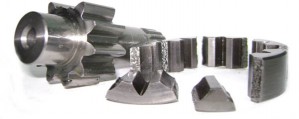

InsaneHydraulics - Sergiy Sydorenko © 2009-2010 All Ridghts Reserved





Back-engineering or reverse engineering
is, quote, the process of analyzing an existing system to identify its
components and their interrelationships and create representations of
the system in another form or at a higher level of abstraction. Reverse
engineering is usually undertaken in order to redesign the system for
better maintainability or to produce a copy of a system without access
to the design from which it was originally produced, end of quote.
In human language, this means that when you have to deal with
a pump you have never seen before, and can't get any
information about its control operation, since the OEMs are profoundly
scared of revealing this "secret" to anybody but their own (dumb ass on occasion)
mechanics, you should take it apart, study it in detail, and then use
the upper part of your body (the head mainly) to come up with the
schematics and understand its operation. Why bother? Because
you can not repair or adjust a pump's control properly unless you fully understand
how it works!
You can't get anywhere in this business without constant
self-education, and hands on, without any doubt, is
the best way to learn. We, mechanics,
technicians, and other workshop-shy-not folks are given the unique chance to study components in
full detail through "direct contact". Catalogues are great, and it is always a time-saver to use
technical literature WHEN you have one, but when you don't -
backengineering is your only option.
There are literally thousands of pump and motor manufacturers throughout the world, but there are only few
basic designs. When you start recognizing them "on the spot", you
realize that all those weird looking adjustment screws, hidden
orifices, spools and the rest of the crap you thought only an engineer
would understand, actually make sense. In fact, the ability to
recognize designs makes handling unfamiliar or "protected" components a "walk in the
park"!
When you strip a hydraulic component, PAY ATTENTION
to details. Ask yourself questions, why is this orifice here? Where
does it lead to? Why is there a spring? What if instead of this orifice
you installed a plug? Be curious, MAKE the details to make sense!
Whenever I disassemble a
pump or a motor, even when it's a familiar model, I always follow
closely all functional orifices, oil passages and valves to the
smallest detail, thus not only reviewing the component's
operation principle, but also detecting problems I would have
omitted otherwise.
Every day I see mechanics who don't give a damn
about what they are stripping down, limiting themselves to being some
kind of disassembling/assembling robots. These chums will never learn
anything this way, but they'll spend the whole f*cking day wining that
life is hard and what they receive in the end of the month is little.
It's going to stay little forever if you don't wake up, people!..
Don't limit yourself to that, take a look at the examples
posted here and start LEARNING. Self-education is the key to success in
hydraulics. Practical reverse engineering of components is a very
interesting way to learn how hydrauic stuff works and exercise your wits.




